Alteration of Articles of Association: An Analysis on AOA
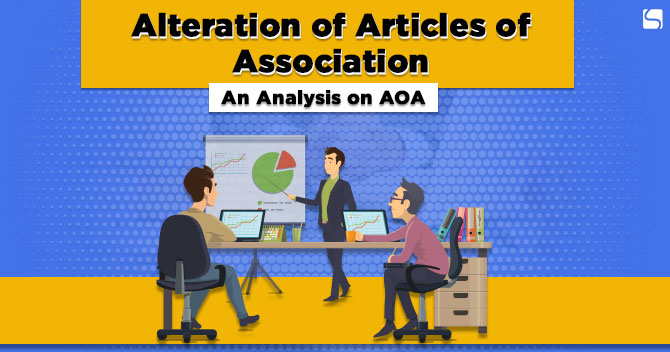
Shivani Jain | Updated: Sep 22, 2020 | Category: Change in Business
The term “Alteration of Articles of Association” denotes a process of modifying or altering the by-laws, rules, and regulations that govern or regulate the Internal Management of a company.
Further, the AOA or Articles of Association creates a balance between the objectives and Mission of a company.
In this blog, we will discuss the concept of Alteration of Articles of Association and its effect on the company.
Table of Contents
Concept of Articles of Association
The term Articles of Association or AOA is parallel to a Rule Book within a Company. This Legal Document includes all the details and information that are significant to govern and regulate the Internal Management of the company.
Further, the details included under the AOA are as follows:
- Shares;
- Details regarding the manner of holding different meetings;
- Role and Powers of the Directors;
Moreover, the definition of “Articles of Association” is provided under section 2(5) of the Companies Act 2013. As per this definition, an AOA comprises of all the rules, regulations, details, and particulars that govern the policies of a company.
Also, every company, whether it is a Private Limited Company, One Person Company, or a Public Limited Company must have a duly drafted AOA (Articles of Association) and MOA (Memorandum of Association) for them.
Need for Alteration of Articles of Association
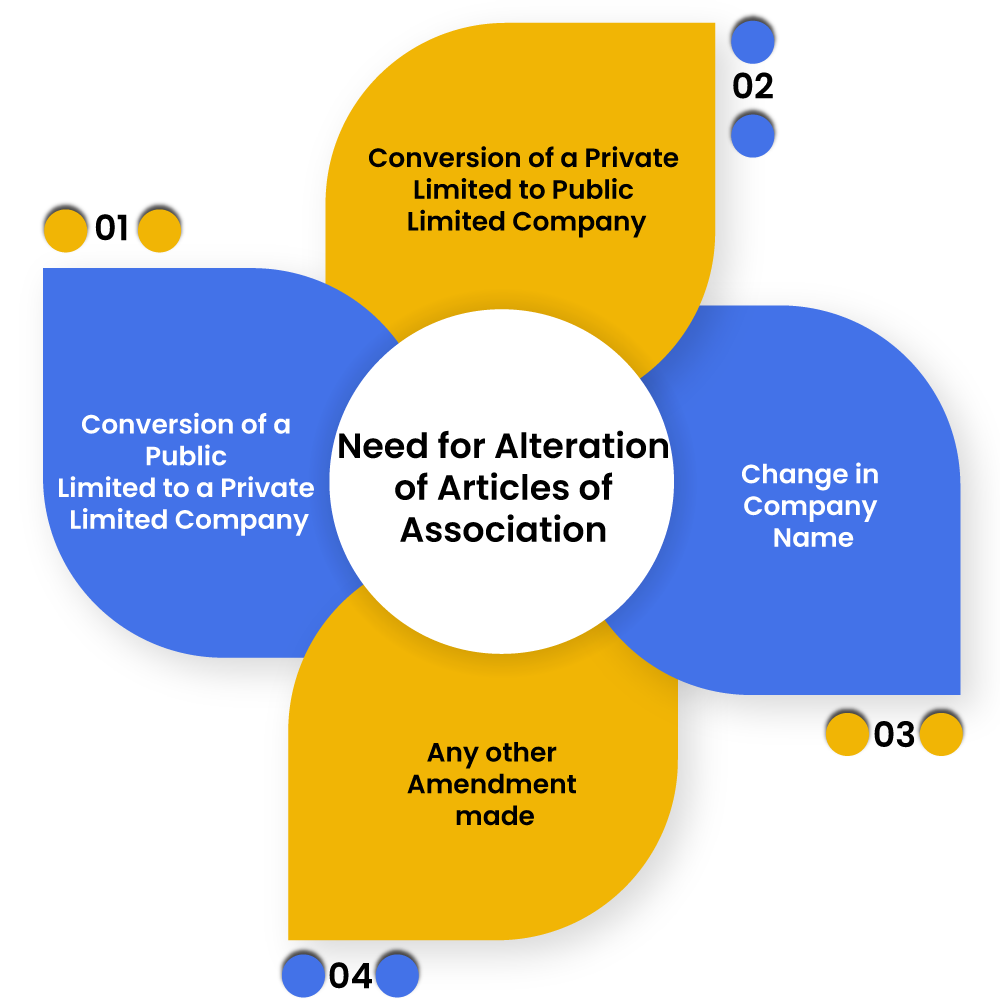
The Reasons for the Alteration of Articles of Association are as follows:
- Conversion of a Private Limited to Public Limited Company;
- Conversion of a Public Limited to a Private Limited Company;
- Change in Company Name;
- Any other Amendment made;
Features of AOA
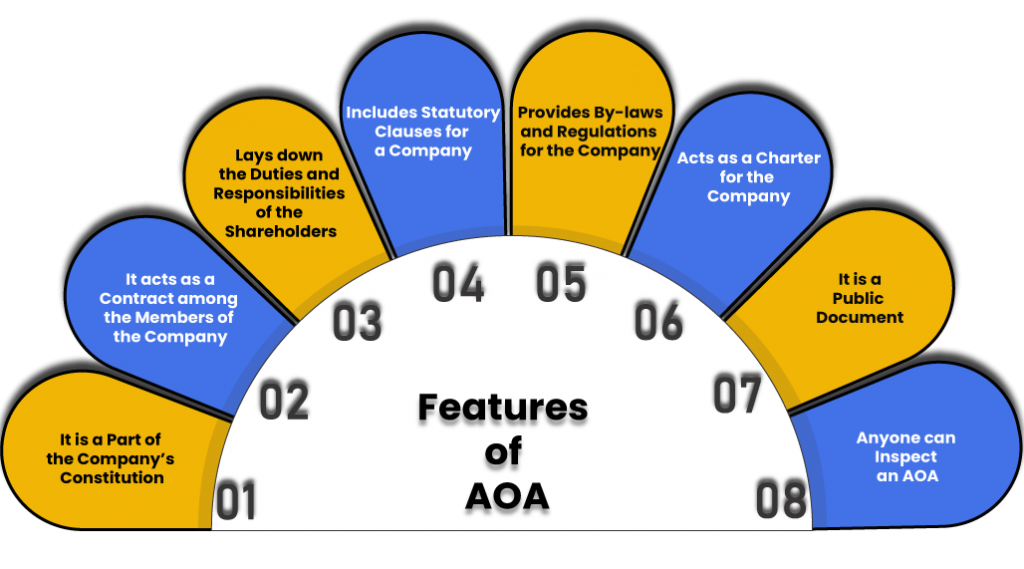
The features of an AOA are as follows:
- It is a Part of the Company’s Constitution;
- It acts as a Contract among the Members of the Company;
- Lays down the Duties and Responsibilities of the Shareholders;
- Includes Statutory Clauses for a Company;
- Provides By-laws and Regulations for the Company;
- Acts as a Charter for the Company;
- It is a Public Document;
- Anyone can Inspect an AOA;
Different Forms of Articles of Association
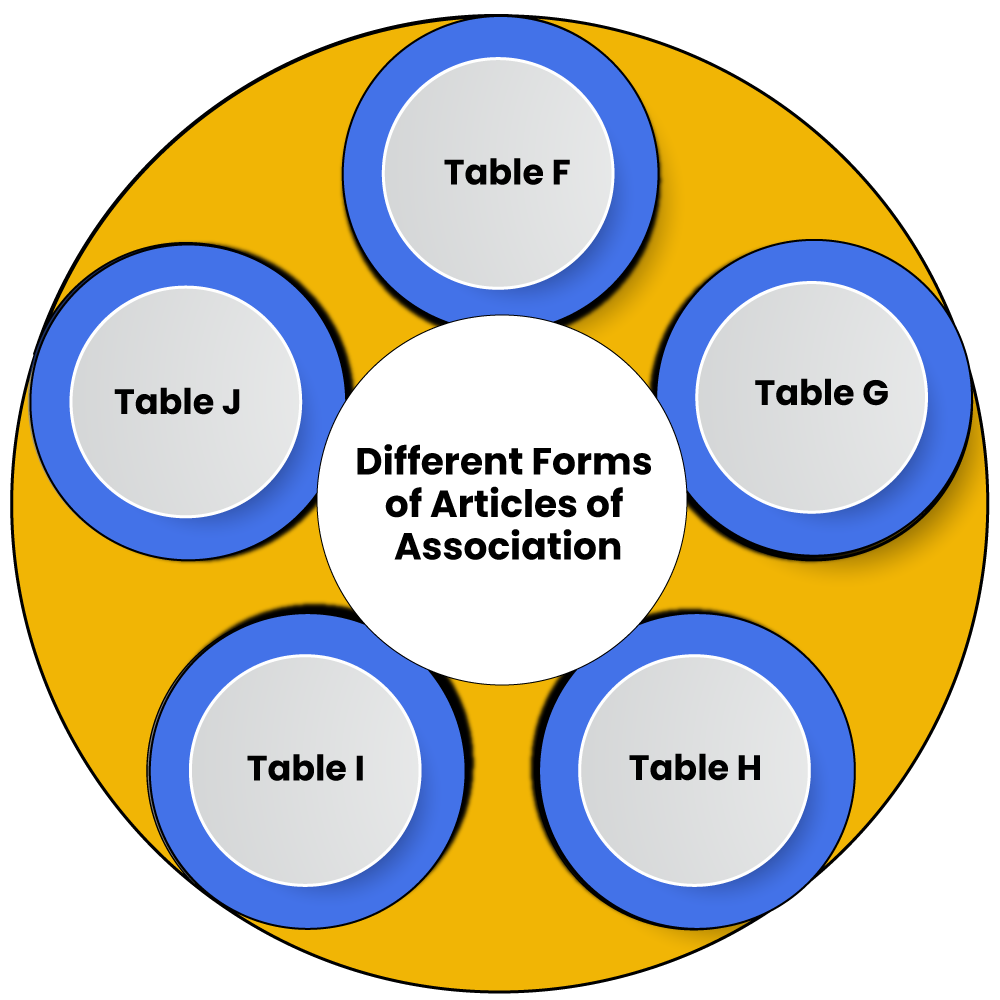
The different forms of Articles of Association are as follows:
| Table | Form of AOA |
| Table F | Articles of Association of a Company Limited by Shares; |
| Table G | Articles of Association of a Company Limited by Guarantee and is having Share Capital; |
| Table H | Articles of Association of a Company Limited by Guarantee but not having Share Capital; |
| Table I | Articles of Association of an Unlimited Company which is having a Share Capital; |
| Table J | Articles of Association of an Unlimited Company which is not having a Share Capital; |
Depending on the basis of the applicability, a company needs to adopt all or any of the rules and regulations contained in the Articles Model.
Contents of an Articles of Association

The contents of the Articles of Association or AOA of a company are as follows:
Share Capital and Variation in Rights
This clause of the AOA or Articles of Association includes the following:
- Sub-division of Shares;
- Rights of Shareholders;
- Relationship of Rights given;
- Share Certificates;
- Payment of Commission;
Lien on Shares
This clause mainly states the provisions regarding the retaining and holding of the possession of shares if in case a member or shareholder of a company is unable to pay off his/her debt back.
Calls on Shares
All the details regarding the whole or partly unpaid amount on each share held by the shareholder are included under this section. In this case, the shareholders need to pay the call money when demanded by the company.
Transfer of Shares
It includes the procedure to transfer the shares held by the shareholder (transferor) to any other person (transferee).
Transmission of shares
All the details concerning the following are included under this section:
- Title Devolution by Succession;
- Death;
- Marriage;
- Insolvency, etc.
Forfeiture of Shares
This section deals with the provision of Forfeiture of shares held by the shareholders. The term “Forfeiture” denotes a situation wherein the shareholder of a company is not able or fails to pay the call money demanded on the shares.
Alteration of Capital
The term “Alteration of Capital” denotes the Decrease, Increase, or Reclassification of Capital as provided by the Articles of Association.
Conversion of Shares into Stock
In consonance with the Articles of Association, a company can easily convert its shares into stock; it just needs to pass an ordinary resolution in a general meeting.
Capitalisation of Profits
The term “Capitalisation of Profits” denotes the use of the Retained Earnings of a company to pay a bonus to the shareholders in the form of additional stock or dividends.
Buyback of Shares
As per the provisions of the Articles of Association, a company has a right to buyback its shares from the shareholders.
General Meetings and Proceedings
All the provisions and regulations relating to the General Meetings (GM) and the manner in which the meetings should be conducted are contained in the AOA or Articles of Association.
Voting rights and Proxy
All the members of a company or their appointed Proxies have a right to cast a vote on certain matters. The manner in which a member or his/her proxy can cast a vote is provided under the provisions of the Articles of Association.
Board of Directors, Board Meetings, and Proceedings
All the provisions regarding the following are provided under the provisions of Articles of Association:
- Appointment of Directors;
- Remuneration of Directors;
- Qualification of Directors,
- Powers of Directors;
- Proceedings of the Board of Directors (BOD) Meetings;
Key Managerial Personnel (KMP)
This section of the Articles of Association provides deals with the Appointment, Remuneration, Duties, and Powers of CEO (Chief Executive Officer), CS (Company Secretary), CFO (Chief Financial Officer), or Manager.
Dividends and Reserves
All the details regarding the distribution of Dividends to Shareholders are provided under this section of the Articles of Association.
Accounts and Audits
The Manner in which the company needs to maintain its books of accounts and records are provided under this section of AOA.
Borrowing Powers
Every company has the power to borrow funds from lending institutions or from any other source. However, the same must be in accordance with the provisions of the Articles of Association of the company.
Winding Up of the Company
All the provisions, rules, and regulations relating to the winding up of the company, together with the manner of dissolving the company, are provided under this part of an AOA.
Is it Mandatory to Sign the Articles of Association?
All the subscribers of an AOA need to sign it compulsorily with their DSC (Digital Signature Certificate). The subscribers also require to provide some details as follows in the presence of at least 1 witness:
- Name;
- Address;
- Occupation;
Further, it shall be relevant to note that all witnesses present must attest signature with their own details and signature.
Procedure for the Alteration of Articles of Association
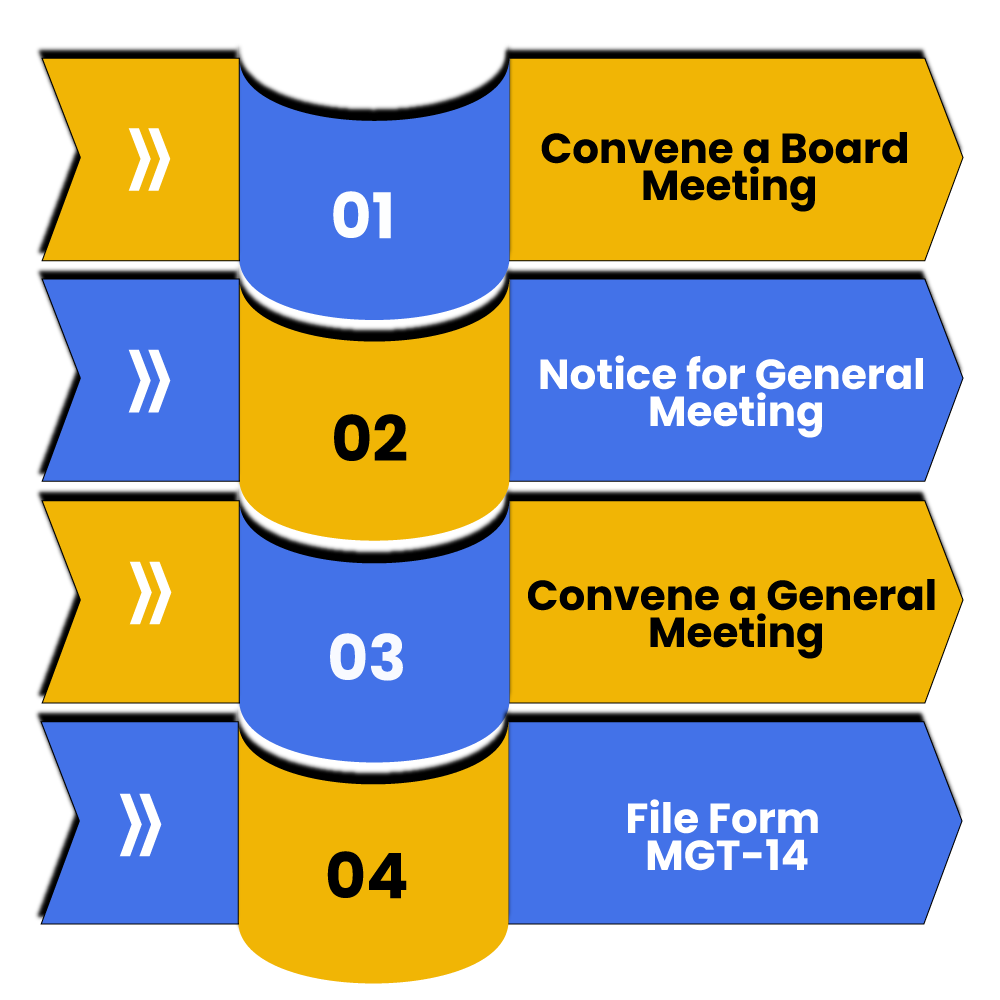
The steps involved in the process of Alteration of Articles of Association are as follows:
Convene a Board Meeting (Section 173 and SS-1)
In the first step, there is a need to convene a Board Meeting to approve or pass a resolution for the process of Alteration of Articles of Association. For the meeting, the company must send notice to its director at least 7 days before the date of the meeting.
Further, the agenda of the meeting will be as follows:
- To Fix a Time, Venue, and Date for Holding a GM (General Meeting) of the company to pass a Special Resolution;
- To Approve the Notice and Agenda of the Meeting;
- As per section 102 of the Companies Act 2013[1] , the notice of a general meeting must have an explanatory as its attachment;
- To Authorise a CS (Company Secretary) or any other officer of the respective company to issue a notice of the meeting as approved by the Board;
However, in the case of a Listed Company, the particulars and details of the AOA of a company are sent to the Recognized Stock Exchange on the conclusion of the Board Meeting.
Notice for General Meeting (Section 101)
Now, in the next step, the company needs to send a Notice of EGM (Extraordinary General Meeting) at least 21 days before the date of actual EGM.
Further, it shall be relevant to note that an EGM can be called on a Shorter Notice as well; the company just needs the approval of majority shareholders for the same.
Moreover, the notice of an EGM or Extraordinary General Meeting will be sent to the individuals as follows:
- Directors;
- Members or Shareholders;
- Auditors of the Company;
Also, the notice of the meeting shall specify the time, date, venue, and shall have an explanatory statement as an attachment. The term “Explanatory Statement” denotes the business or agenda to be transacted at the meeting.
Convene a General Meeting (Section 101)
Another step in the process of Alteration of Articles of Association is to pass a Special Resolution for the same.
However, in the case of a Listed Company, the directors need to forward a copy of the proceedings of the GM (General Meeting) to the concerned recognised stock exchange according to the provisions of the SEBI (Listing Obligations and Disclosure Requirements) Regulations, 2015
File Form MGT-14
In the last step of the procedure for the Alteration of Articles of Association, the directors of the company need to file a copy of the Special Resolution passed in Form MGT 14 with the Registrar of Companies, Indi, within 15 days of passing such resolution.
Further, the documents to be annexed with the MCA Form MGT-14 are as follows:
- Certified Copies of the Special Resolution;
- Explanatory Statement;
- Copy of the Notice of Meeting sent to Members; and
- A Printed Copy of the Altered AOA;
Key Points for the Alteration of Articles of Association
The points to be considered for the alteration of Articles of Association are as follows:
- Any Kind of Alteration done must be notified in every copy of the Articles. These copies are sent to the members on a request within 7 days;
- In case a company makes any default in complying with the regulations and provisions of alteration of articles of association, then every officer of the company in default will be liable to pay Rs 1000 for each passing day to up to Rs 1 lakh as the case may be;
- Alteration of Articles of Association must not be done for the sake of doing illegal activities or business;
Effects of the Alteration of AOA
The effects of the alteration of articles of association are as follows:
- Alteration of Articles of Association bound the member with the company;
- Altered AOA will govern the Internal Management, Business, and Administration of the Company
Conclusion
The Articles of a company acts as a rule book for the company. It not only defines the rights and duties of the directors but provides various means through which the shareholder can exercise control over directors and the company as well.
Further, the Alteration of Articles of Association denotes a process of modifying or altering the by-laws, rules, and regulations that govern or regulate the Internal Management of a company.
In case of any confusion, reach out to Swarit Advisors, our experts will not only provide the clear and lucid learning of the concept but will guide you through the process of the alteration as well.
Also, Read: Alteration of MOA: Guide to Alter Memorandum of Association.














